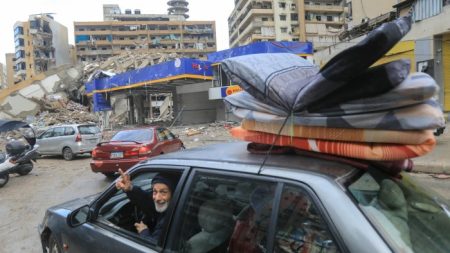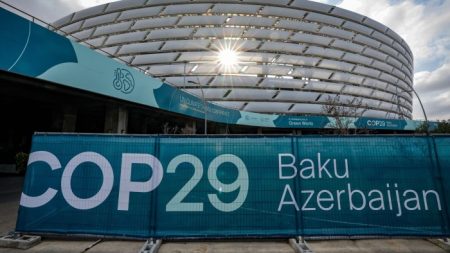There was a huge kerfuffle surrounding the news earlier this month that Edward Enninful was stepping away from his role as editor-in-chief of British Vogue. Meanwhile, the communications team at Condé Nast (Vogue’s publisher) decided to postpone the announcement that Venya Brykalin had just been appointed to the same position at Vogue Ukraine. The country had just suffered a fatal air strike, and so they thought it respectful to pause the press release for a few days.
When I saw Brykalin last week at an event in London, he was working on a piece from a writer in Nova Kakhovka, a small town that had been flooded after the destruction of the Kakhovka dam. She’d had to make last minute edits as her father’s house, with all the family’s belongings and memorabilia, had just been submerged.
Perhaps the biggest surprise about Vogue Ukraine is that it exists at all. It seems unconscionable that anyone would want or need a fashion magazine to look at while the country is so embattled. How could any editor try to navigate such content? But Vogue Ukraine, founded in the shadow of the Maidan revolution in 2014, and published under licence from Condé Nast by Vanguard Media, an independent Ukrainian media company, has never been simply a “glossy” magazine.
Its editors are stylish, passionate and fiercely patriotic: until the invasion the team had worked hard to educate readers — especially the magazine’s commercial sponsors — that Ukraine was distinct and separate from Russia. Since the invasion, they have focused on the war effort. After the invasion, which began at 4am on February 24 2022, the print edition was put on hold temporarily, though the web editors continued working: the first online piece was published at 9am that morning and the team, which is now spread around Ukraine and elsewhere in Europe, continues to write about what is happening day to day. The beauty editor, Alyona Ponomarenko, has focused on stories about psychological help and mental support during wartime. The team has published stories on first aid, how to survive air strikes and “most recently floods”, says Brykalin.
Meanwhile, the magazine has resumed production. The most recent edition, “The Road of the Unbreakable”, published this spring, was a commemorative issue centred on a “heroes” project featuring 50 individuals and collectives that have contributed to the fight, including Ukraine’s first lady Olena Zelenska, Kyrylo Budanov, the head of state intelligence, athletes, artists, writers, volunteers and, naturally, fashion designers.
“There is no textbook on how to run a magazine, let alone a fashion title, during the war,” says Brykalin, who has been at Vogue Ukraine since 2017. “There were a lot of heated discussions on how this issue should look and what kind of stories we wanted to tell. But we all agreed the issue had to reflect what was happening in a way that was respectful and also hopeful.” The cover, an abstract work by Vasylyna Vrublevska resembling the Ukraine flag, prefaced a series exploring how “our normal life has been destroyed”, Brykalin continues. “We felt it was important to have those in the issue as a memory and a historical document.”
“The Road of the Unbreakable” issue sold out immediately; it has since been reprinted and distributed far more widely with a spike in global orders. Although it has a circulation of only 44,000, the magazine has become a powerful messenger. As Brykalin says: “We are one of the very few, if not the only, international brands coming from Ukraine that people know. So a lot of readers outside of the country have been looking to us for news because they trusted us.”
Vogue has a history of publishing during wartime. British Vogue continued to roll out throughout the Blitz, and its physical appearance alone became a symbol of patriotic, stiff-upper-lipped stoicism. With advice extending to such domestic activities as making one’s fabric coupons go further, or how to cook with powdered eggs, its intentions back then — to foster a spirit of hope, compassion and community among its readers — were no different to the Ukraine team’s ambitions now.
Watching the evolution of Vogue Ukraine has also been a study in the flexibility of a brand name. Check the magazine’s Instagram feed right now and you’ll find profiles of military leaders alongside pictures from the Met Ball, street style and an article about a foundation saving orphaned babies. It’s a curious but not uncomfortable blend of content, but it reflects that even in the most barbaric circumstances, people want a break.
Vogue Ukraine’s future is far from assured. The magazine is just as vulnerable to the supply stoppages and mortar attacks as any other Ukrainian business. For now, the work continues. “People joined Vogue Ukraine not because of the lifestyle but because they had the drive to create something meaningful,” says Brykalin. In doing so, they are pushing the Vogue name to its limits.
He also reminds us of a basic truth. We spend so much time examining core values and DNA in fashion that we forget that consumers respond quite positively, in general, to things that offer helpfulness, humanity and hope.
Email Jo at [email protected]
Follow @ftweekend on Twitter to find out about our latest stories first
Read the full article here













